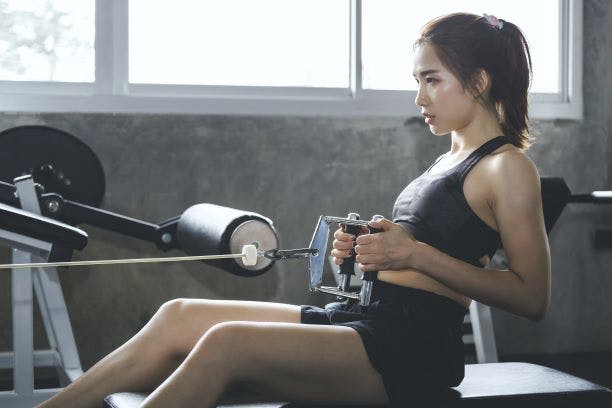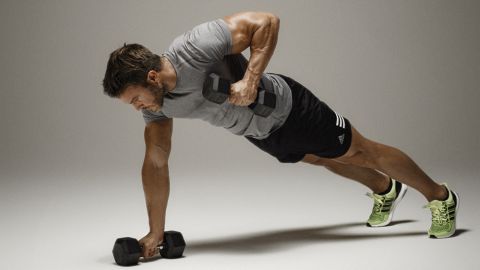If you are interested in strengthening your core and shoulders you should be performing some type of row exercise variation. The row exercise is a pulling movement that involves bending your elbow, extending your shoulder, and pulling your shoulder blade back. The row challenges the muscles of your upper back. These are your trapezius, rhomboids, and erector spinae. It also activates the muscles of your core and low back.
When you do the row exercise in standing you train your entire kinetic chain from your lower body, through your trunk, and into your upper body. This article shows you 5 different row exercises to train your shoulders and core.
Why the Machine Row Exercise is Not Ideal
It is common for people to do rowing exercises seated with exercise machines. This is fine if you are first learning the movement pattern. However, seated machine rows do little to challenge your core or lower body. You have much better options if you are an athlete, have a history of injury, or if you are simply looking to take your workout to the next level.

If absolute strength is your goal, heavy barbell or dumbbell bent-over rows are your best options. However, these row exercise variations require coaching and practice to perfect proper technique. Performing heavy rows with improper technique makes you susceptible to low back or shoulder injury. Again, there are better options, especially if you have a history of injury. Instead, try the following 5 row variations and see which ones work best for you.
Standing 1-Arm High Cable Row
Set up a cable system with the cable slightly above the level of your head. Stand in a lunge position with your left foot in front of your right. The majority of your body weight is on your front leg with your knee bent about 45 degrees. Start with your palm down gripping with your right arm extended out in front of you. Pull the cable, bending at your elbow, straight back towards your trunk while maintaining a neutral spine. Be sure to emphasize scapular retraction. This refers to pulling your shoulder blade back and slightly down. Also, avoid shrugging your shoulders or arching your low back.
This exercise challenges your core by activating your trunk muscles to resist rotation as your arm and scapula produce the movement. This makes the 1-arm high cable row a good option if you are looking to train anti-rotational trunk muscle endurance. This high-cable position and lunge stance set-up also result in favorable muscle activation patterns of the lower and upper trapezius. This is important if you are an overhead athlete or have a history of shoulder problems.
Cable Lawnmower Pull
This exercise begins with your trunk flexed and rotated to the opposite side of your exercising arm. The hand of your exercising arm starts at the level of your other knee.
To begin the movement, rotate your trunk toward your exercising arm while extending your hip and trunk to a vertical position. The exercise ends with your arm at waist level with your shoulder blade retracted as if placing your elbow in your back pocket. Pause for 1 or 2 seconds then slowly reverse the movement returning to the starting position.
The lawnmower pull is a multi-joint functional exercise performed in a diagonal pattern replicating many movements in sport. The exercise incorporates the transfer of force from your lower body through your trunk to your upper body. It activates your trapezius and serratus anterior muscles at low to moderate levels. These muscles are important for maintaining shoulder health in overhead athletes (i.e., baseball players) and those with a history of shoulder pain. The exercise can be performed with a cable system, resistance band, or dumbbell.
1-Arm Band Rotational Row
Set up a resistance band anchored at your waist to belly button level. Position your front leg with the foot facing towards the anchored band. Your rear leg will begin facing the same direction but must be free to pivot once the exercise commences. Your right arm begins extended and the majority of your body weight begins on your left leg.
The movement occurs with the simultaneous coordination of an upper-body row, trunk rotation, and weight shift to your rear leg. Pause in the end position for 1 to 2 seconds before reversing the movement in a slow and controlled fashion.
This row variation is ideal for rotational athletes such as baseball players. It incorporates the coordinated activity of your lower body, trunk, and upper body. Controlling the eccentric, or negative, part of the exercise is important. This exercise also teaches weight transfer and weight acceptable from your rear to lead leg and vice versa. Be sure to perform the exercise from both sides to avoid reinforcing any side-to-side asymmetries which are common in athletes.
Suspension Trainer Row
Anchor a suspension trainer, such as a TRX, in an overhead position. Grasp both handles with your arms extended. Position your feet in front of your body spread slightly wider than shoulder-width apart. Your body should be maintained in a neutral position with your head, trunk, and legs forming a straight line.
Perform the row movement and pause at the top position for 1 to 2 seconds before returning to the start position in a slow and controlled fashion. Maintain your trunk in a rigid position throughout the exercise. To increase the challenge of this exercise position your feet further away from your upper body to assume a more inverted position.
The inverted position in the suspension trainer row exercise elicits high activation of your abdominals, latissimus dorsi, upper back muscles, and hip extensor muscles (glutes and hamstrings). This exercise produces lower levels of lumbar spine muscle activity. This is due to lower spine loads incurred from the suspended position. These factors make the suspension trainer or inverted row a good option for people with a history of low back pain.
Dumbbell Renegade Row
Hold 2 dumbbells and assume a push-up position with your feet spread slightly wider than shoulder-width apart. Align your head, trunk, and lower body in a straight line and maintain this position throughout the exercise.
Initiate a row with one arm while maintaining stability through your trunk and lower body. Control the descent of the load back to the floor. Be sure to alternate sides with each repetition. Light loads are recommended when first learning this exercise.
The push-up position utilized in the renegade row increases challenges to your abdominal muscles. Furthermore, 1-arm row variations have been shown to elicit greater oblique abdominal muscle activity compared to rows performed with both arms simultaneously. This is a more advanced row variation. It may be best to start with cable or suspension rows before embarking on the renegade row.
Incorporate Row Exercise Variations into Your Workouts
There are many variations to the rowing exercise. We have described only 5 here. For beginners, it is best to start with cable row variations and suspension trainer rows. The lawnmower pull and rotational row are more complex movements that require total body coordination. Thus, these exercises are more challenging to master. To really challenge the core and shoulder stability, the renegade row is a higher-level option.
The most important points are that you choose the most appropriate variation for your level of training and that your technique is as close to perfect as possible. If you would like help getting started, call your physical therapist and set up an appointment.


